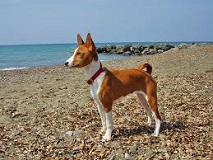The Basenji (also known as the Congo Dog) is a hunting dog breed that originated in central Africa. There have been found traces of a similar looking dog in Egyptian tombs and wall drawings of five thousand years ago.

The Africans used this dog breed when hunting in the forest, to warn them if a dangerous animal would approach, or for pointing and retrieving small game. It was first introduced to England in 1937, where English breeders refined it and exported it all over the world.
This breed has unusually shaped larynx, so the barking sounds rather like a yodel noise. This feature gave the Basenji the nickname “Barkless Dog”, though it can also howl, crow and growl depending on its mood.
Their height is between 16 and 17 inches (41-43 cm) in dogs and 15-16 inches (38-41 cm) in bitches and they weigh between 9 and 12 kg (20-26 pounds).
The Basenji is a small, muscular, elegant-looking dog with small, erect, ears open in the front. Its skull is flat and its head is wrinkled around the forehead. It has straight legs and a tightly curled tail. The coat is fine, short and comes in red, black, tricolor combinations (black, tan, white) or brindle (black stripes and red background).
It is an affectionate, curious and energetic dog, it responds well to training and it has a strong desire to please. It forms strong bonds with humans, but is somewhat reserved at first.
It needs daily exercise and is tireless in play, dislikes wet weather and is not to be trusted around non-canine pets.
This breed requires an owner who can display natural authority, as it has the tendency to become demanding and will assume the role of pack leader. It can be a wonderful pet if the owner understands canine behaviour and treats the dog accordingly, as it is the second least trainable breed according to the book “The Intelligence of Dogs”.
The Basenji is a great apartment pet, if it gets enough exercise and is very active indoors. This breed needs long daily walks, and, if the owner doesnt stick to a regular schedule of vigorous exercise, the dog can become fat and lazy.
This breed is excellent for people with allergies, because it sheds little to no hair, washes itself like a cat and has no doggie smell.
Most breeds come into heat twice a year, but the Basenji female only comes into heat once a year (like dingoes).
The median lifespan for this breed is 10 to 13 years. It often suffers from Fanconi syndrome (kidney problems unusually common in Basenjis), which must be treated the moment any symptom is noticed (excessive drinking, excessive urination, glucose in the urine); other common conditions are intestinal and eye problems, progressive retinal atrophy (which causes blindness) and hip dysplasia. This breed must be tested for glucose in the urin once a month, beginning at the age of 3.
Dogs who strikingly resemble the Basenji have been living with humans for thousands of years, proof of this fact being the tombs of Egyptian pharos on which you can see them sitting at the feet of their masters, looking just as they do today: respectful, devoted, vigilant, silent guards.




